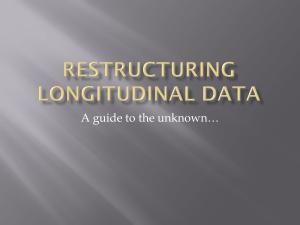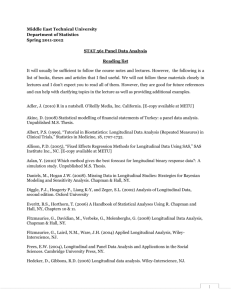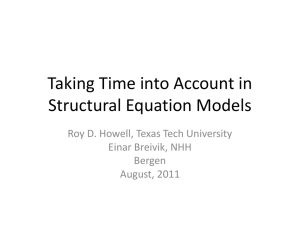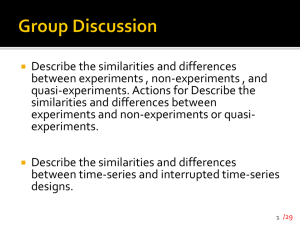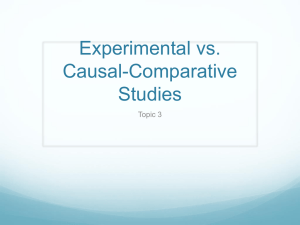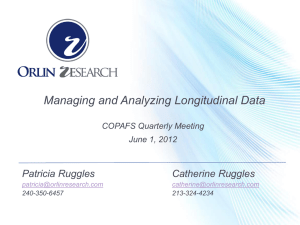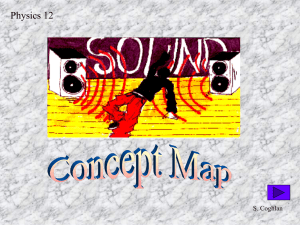Meta Data Standards for Managing and Archiving Longitudinal Data
advertisement
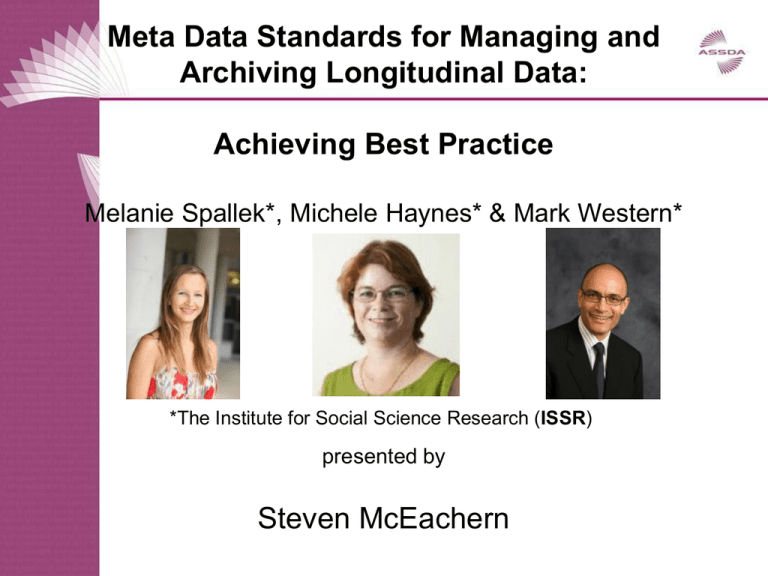
Meta Data Standards for Managing and Archiving Longitudinal Data: Achieving Best Practice Melanie Spallek*, Michele Haynes* & Mark Western* *The Institute for Social Science Research (ISSR) presented by Steven McEachern ASSDA – Queensland node Brisbane Institute of Social Science Research at the University of Queensland WHY • Cross-sectional and longitudinal data structure is different • Current meta data standards not sufficient • Great need for international standard in best practice for archiving longitudinal data Overview • Cross-sectional studies versus longitudinal studies >different types of longitudinal studies • Major longitudinal studies archived with ASSDA • Challenges with documenting longitudinal studies • Compare meta data standards internationally • Future plans at ASSDA Cross- sectional • Multiple variables observed at a single point in time • One- dimensional Longitudinal • Repeated observations over time • Two or more dimensional • Change over time, causeeffect, shifting attitudes Different types of longitudinal studies • Repeated cross-sectional studies > new sample at different points in time > represents snapshot of population at each time point > aspect of individual’s change not available • Cohort studies > group of individuals at a similar state in the life course, studied over time > problems with drop-outs • Household panels > Household as a study unit > Number of individuals can vary (move in, move out) Major longitudinal studies archived with ASSDA • Negotiating the Life Course (NLC) > 1500 participants at wave 1 in 1996 > five waves archived so far • Australian Longitudinal Study on Women's Health (ALSWH) > three cohorts (younger, mid-aged, older) > 40,000 participants at wave 1 in 1996 > four waves archived for the younger and older cohorts and five for the mid-aged cohort • Australian Longitudinal Survey of Ageing (ALSA) Professor Mary Luszcz with the oldest ALSA participant who is 108 years old. > 2,087 participants at wave 1 in 1992 > seven waves archived so far • Longitudinal Surveys of Australian Youth (LSAY) > 13,613 participants at wave one in 1995 > all four waves have been archived • Longitudinal Survey of Immigrants to Australia (LSIA) >Phase 1 (three waves) and Phase 2 (two waves) have been archived Meta data standards used at ASSDA • DDI2 is used for describing cross-sec and longitudinal data • coverage of DDI2 is focused on single studies, single data files, simple surveys and aggregated data files • metadata requirements for longitudinal studies differ from that of cross-sectional studies and also across types of longitudinal studies • DDI3.1 supports the description of longitudinal data, but few archives have facilitated DDI3.1 yet Challenges • Combining Data on Same Individuals from Repeated Surveys – How do longitudinal studies name comparable variables at different surveys? – What tools are in place to easily identify variables and their comparability? – What makes a variable incomparable? variable survey name values question variable relates to non existent 1 m1q30b n/a Over the last 12 months, how stressed have you felt about the following areas of your life: Health of other family members. 1 n/a, 2 not at all stressed, 3 somewhat stressed, 2 m2q30b 1,2,3,4,5,6,. 4 moderately stressed, 5 very stressed, 6 extremely stressed Some women have experienced difficulties in becoming pregnant. Have you ever had any of the following problems with fertility: You were 3 m3q30b 0,1,. diagnosed as infertile by a doctor? 1 yes, 0 no non existent 4 m4q30b n/a Thinking about your own health care, how would you rate the following: Access to hospital if you need it. 5 m5q30b 1,2,3,4,5,6,. 1 excellent, 2 very good, 3 good, 4 fair, 5 poor, 6 don't know Incomparability Survey 1: Marriage improves your health Agree Disagree Survey 2: Marriage improves your health Strongly Agree Strongly Disagree Challenges • Combining data on same individuals from repeated surveys – How do longitudinal studies name comparable variables at different surveys? – What tools are in place to easily identify variables and their comparability? – What makes a variable incomparable? • Updating longitudinal surveys Updating Longitudinal Surveys • Additional logic check within a study participant between surveys across time • S1 S2 • S1 Osteoporosis S2 Osteoporosis S3 Osteoporosis S3 Comparisons among International Archives • UK Data Archive’s Survey Question Bank http://surveynet.ac.uk/sqb/introduction.asp • CentERdata uses some DDI3.1 http://www.lissdata.nl/dataarchive/concepts • Other archives have not been found to address issues relating meta data for longitudinal data archiving Future Plans at ASSDA • Website for longitudinal data archiving • Provide guidelines for data dictionary and variable map development • Require data dictionary and variable map with deposit of longitudinal data Website/ Contact Australian Social Science Data Archive 18 Balmain Crescent The Australian National University ACTON ACT 0200 Email: assda@anu.edu.au, m.spallek@uq.edu.au Website: www.assda.edu.au Phone: +61 2 6125 4400 Fax: +61 2 6125 0627
